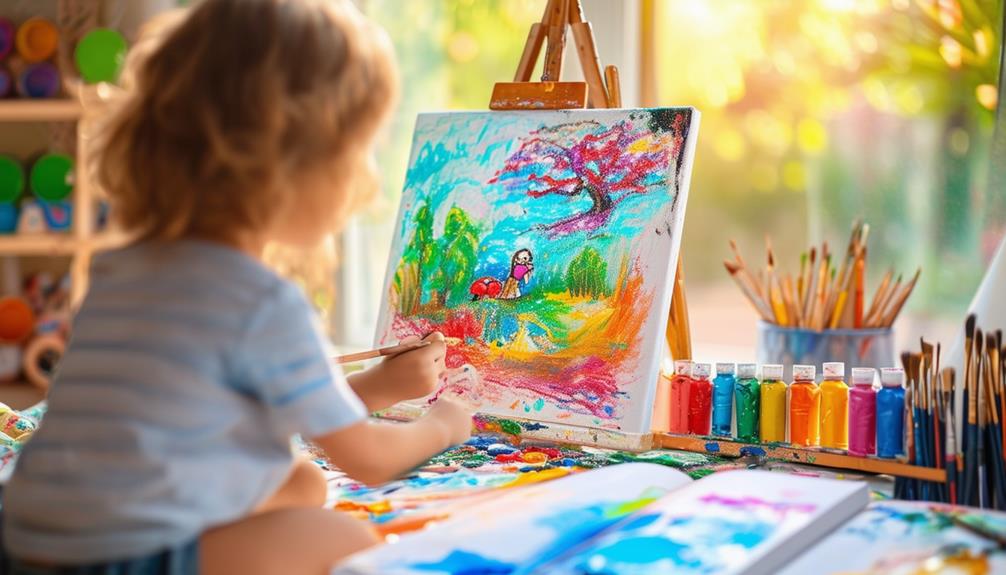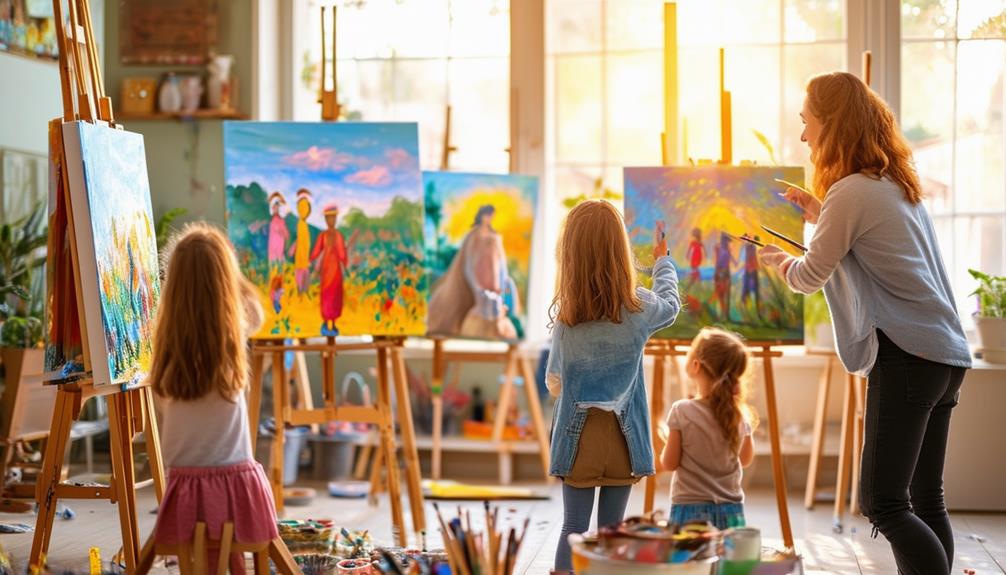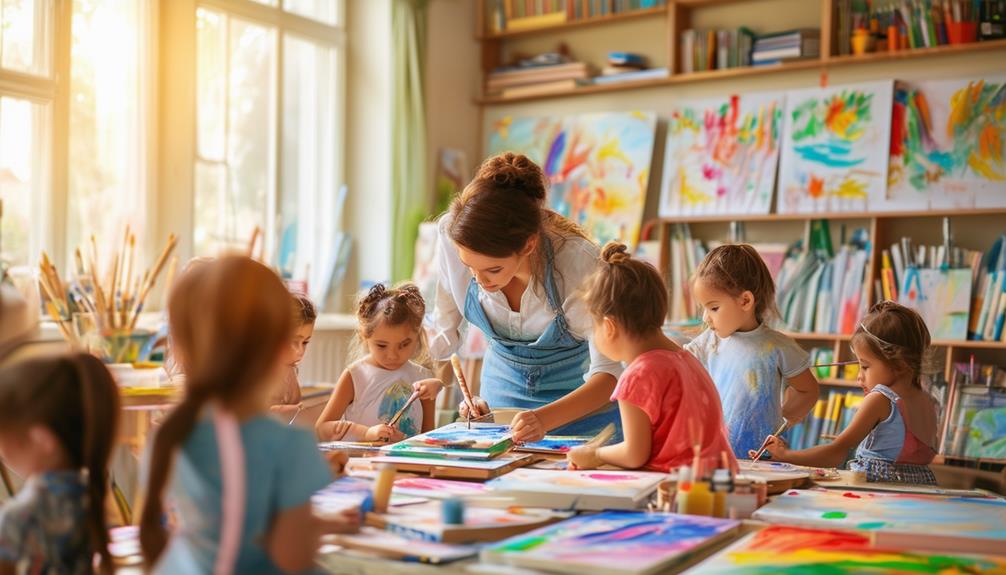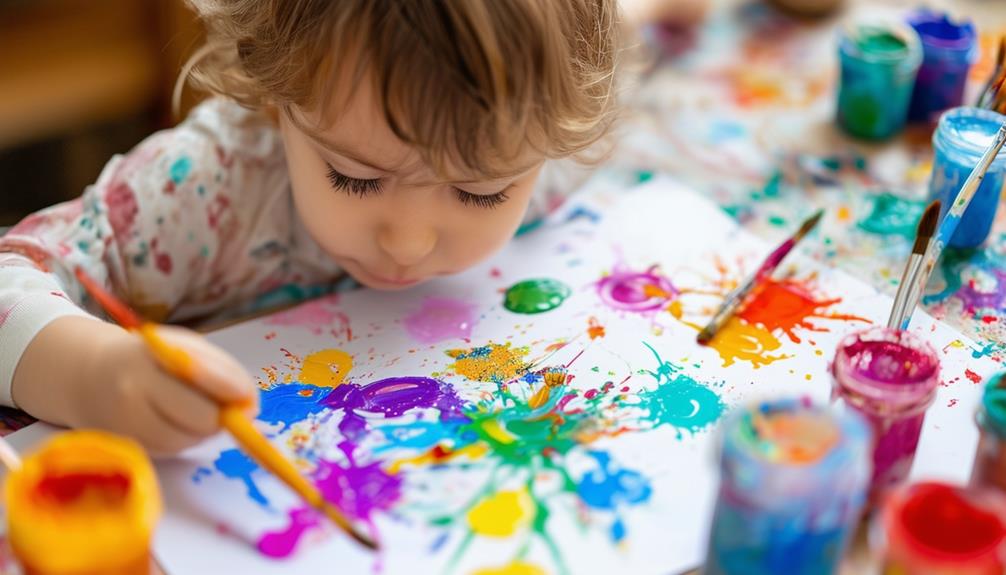Storytelling Through Painting: Encouraging Narrative Skills

Imagine guiding children to develop their narrative skills by interpreting paintings. You can encourage them to investigate the visual elements, prompting creativity and imaginative thinking. As they engage with the artwork, they will start crafting their own stories, developing characters, and expressing emotions. This method not only improves storytelling abilities but also fosters critical thinking and communication. So, how can these strategies benefit children's cognitive and socio-emotional development?
Benefits of Storytelling for Children
Integrating storytelling into children's lives significantly enhances their socio-emotional skills and cognitive abilities. Encouraging children to engage in storytelling provides them with a powerful means to express their thoughts and emotions, thereby supporting their mental health and well-being. This process fosters relaxation and emotional clarity. Storytelling involves both speaking and listening, helping children build empathy and strong communication skills.
Encouraging children to participate in storytelling through art helps them visualize stories more vividly. When children create their versions of stories through painting or drawing, they immerse themselves in a colorful world that enhances their cognitive and developmental growth. This practice nurtures a love for art and improves their ability to communicate complex ideas in a simple, visual form.
Storytelling Vs. Storyreading
When you compare storytelling to storyreading, you'll notice how storytelling actively engages children, encouraging their creativity and visualization skills. Through storytelling, children become participants rather than just listeners, fostering a deeper connection to the material. This interactive approach not only sparks imagination but also promotes higher levels of engagement and learning.
Interactive Engagement Benefits
Storytelling, in contrast to storyreading, actively engages children by encouraging them to create their own versions of stories and visualize the narrative through painting. This interactive method promotes critical thinking as children interpret and transform the narrative into visual art. Instead of passively listening, they become active participants, captivating even the most reluctant learners.
Through storytelling, children express their thoughts and emotions creatively, supporting their mental health and well-being. Painting their stories enables them to form personal connections to the narrative, fostering deeper understanding and retention.
Here's a comparison to highlight the benefits of interactive engagement:
| Aspect | Storytelling | Storyreading |
|---|---|---|
| Engagement Level | High - Children create and visualize stories | Moderate - Children listen and imagine |
| Critical Thinking | Encourages interpretation and creation | Limited to understanding the given narrative |
| Emotional Expression | High - Children express emotions through painting | Low - Mostly passive emotional connection |
| Cognitive Development | Enhanced through active participation and visualization | Developed through listening and comprehension |
This comparison underscores the value of storytelling in fostering critical thinking, emotional expression, and cognitive development through active engagement.
Creativity and Visualization
Building on the advantages of interactive engagement, let's explore how storytelling through painting ignites creativity and enhances visualization skills in children. Storytelling through art inspires kids to craft their own narratives, nurturing rich imaginations. Unlike story reading, which is more passive, storytelling through painting requires active participation. This involvement not only entertains but also stimulates creative thinking.
When children use painting in storytelling, they visualize concepts and characters directly on the canvas, which reduces the need for extensive leaps of imagination. This direct form of expression allows them to interpret visual media more effectively. Seeing their ideas come to life in a tangible form enhances their confidence in their creative abilities.
Art, as a medium for storytelling, offers a unique way for children to express their thoughts and emotions. Instead of simply absorbing information, they become creators, enriching their ability to think critically and creatively. By encouraging storytelling through painting, you're not just helping children develop narrative skills; you're also giving them the tools to visualize and articulate their ideas in original ways. This dual benefit underscores the value of integrating art into educational practices.
Learner Participation Levels
Children's engagement significantly increases when they actively participate in storytelling compared to the more passive experience of storyreading. In storytelling, children do more than just listen—they create, imagine, and explore diverse narratives. This active involvement enhances their narrative skills beyond the confines of a written page. They become co-authors, adding their own twists to the story, which fosters creativity and imagination.
Conversely, storyreading is a more passive activity where kids listen to a story with limited room for interaction or personal input. While reading is undoubtedly valuable, it does not offer the same level of cognitive and developmental growth as storytelling. For example, storytelling through painting allows children to visualize scenes and characters, encouraging them to interpret visual media uniquely. This enriches their creative skills and supports cognitive development.
Furthermore, storytelling through art can engage even the most hesitant learners. When children paint their stories, they become more invested in the creative process, making the learning experience both enjoyable and enriching. Encouraging children to explore diverse storytelling methods can significantly enhance their participation levels and overall learning outcomes.
Importance of Art in Storytelling

Incorporating art into storytelling allows children to visualize narratives, facilitating a deeper connection with the story. Art education is crucial here, as it equips children with the tools and techniques necessary to create their own visual interpretations. This means they don't just hear or read a story; they witness it come to life.
Artistic storytelling offers children a unique avenue to express their thoughts and emotions that words alone may not fully capture. The visual emphasis of art encourages kids to analyze visual media, thereby enhancing their cognitive and developmental growth. When children engage in creating art to narrate a story, they reflect on the narratives more profoundly, fostering a love for both the art and the storytelling process. This synergy between art and storytelling cultivates essential skills that are beneficial in various life aspects.
The impact of art in storytelling on children can be summarized as follows:
| Aspect | Benefit | Impact |
|---|---|---|
| Visualization | Easier connection to the story | Improved comprehension |
| Expression | Creative means to express thoughts | Enhanced emotional articulation |
| Cognitive Growth | Promotes developmental skills | Strengthened cognitive abilities |
Strategies to Encourage Storytelling
To encourage storytelling through painting, begin by presenting artworks that illustrate myths or captivating stories. Invite children to examine these paintings closely and envision the narratives they portray. Encourage them to invent new characters and interactions, enriching the story beyond the depicted image.
Painting-Driven Narrative Prompts
Using painting-driven narrative prompts can inspire children to craft their own imaginative stories based on visual art. These prompts provide a foundation for storytelling by encouraging kids to observe and interpret paintings. They can immerse themselves in creativity by imagining characters, settings, and plotlines derived from the artwork.
A prompt might start with a simple question: "What is happening in this picture?" Encourage children to look closely at the painting and describe what they see. Ask them to think about who the people or creatures in the painting might be and what they might be doing. This stimulates creativity and helps them express their thoughts and emotions through art.
Another effective prompt is to ask, "What happened just before this scene?" or "What do you think will happen next?" These questions help children build a narrative around the visual elements, bringing the painting to life with stories of adventure, mystery, or everyday occurrences.
Combining visual arts with storytelling fosters an engaging and imaginative learning experience. By encouraging children to create narratives based on paintings, you're helping them develop their storytelling skills in a fun and interactive way.
Visual Storytelling Techniques
Guiding children to step into a painting and weave their own narratives transforms the artwork into a playground for imagination. By encouraging them to observe paintings in detail, you can spark their creativity and storytelling skills. Point out different elements within the painting and ask open-ended questions about what might be happening beyond the visible scene. This helps children explore the human experiences depicted in the artwork, making connections between the visual cues and their own imaginative stories.
Encourage them to create new characters and interactions based on what they see. For instance, if a painting shows a busy marketplace, ask children to imagine the lives of the vendors or the adventures of a child in the crowd. This not only improves their communication skills but also promotes cognitive development as they think critically about their narratives.
Visual storytelling techniques allow children to delve into layers of meaning and emotion within the painting, fostering a deeper understanding of human experiences. By guiding them to go beyond the visible, you help them cultivate their creativity and storytelling abilities, turning each painting into a rich, narrative-filled world waiting to be discovered.
Creating Interactive Art
Building on visual storytelling techniques, you can enrich children's creativity by engaging them in interactive art. This approach not only makes the art process more dynamic but also helps children develop narrative skills in an enjoyable manner.
Start by providing a simple drawing as a creative prompt. Encourage children to add to the story depicted in the drawing without dominating the narrative. This allows them to take ownership of their storytelling journey. Prompt them to incorporate motion and action into their drawings, which enhances the storytelling experience and animates the narrative.
Collaborate with children to bring the story in the drawing to a satisfying conclusion, fostering a sense of accomplishment and collective creativity. Here are three strategies to encourage interactive art and storytelling:
- Create a Storyboard: Break down the story into panels, allowing children to add details and ensure continuity.
- Add Interactive Elements: Use movable parts or flaps in the artwork to reveal hidden story aspects.
- Encourage Group Projects: Let children work together on a large canvas, integrating their ideas into one cohesive story.
Developmental Benefits Through Art

Engaging regularly in storytelling through painting significantly enhances children's communication skills by encouraging them to visually express their thoughts and emotions. This practice boosts their mental health by providing an outlet for emotion regulation and stress relief. By translating their feelings into colors and shapes, children develop healthier ways to process complex emotions, which is crucial for their overall well-being.
Artistic storytelling also fosters cognitive growth. As children reflect on their narratives, they begin to question preconceptions, thereby enriching their critical thinking. They learn to observe and interpret visual media, skills that are invaluable in an increasingly visual world. This process supports cognitive development by enhancing problem-solving and analytical abilities.
Moreover, using painting as a storytelling tool enables children to visualize their stories, making abstract ideas more tangible. This visualization process is vital for developing strong narrative skills.
The Power of Art Education
Engaging in art education enhances your imagination and creativity, particularly through storytelling in painting. It also teaches emotional expression techniques and fosters a deeper appreciation for diverse cultures. This combination enriches your understanding and connection to the world around you.
Imagination and Creativity Boost
Through art education, you can ignite imagination and creativity in children, which are crucial for developing their storytelling abilities. When students engage in storytelling through painting, they visualize their ideas and express them uniquely and compellingly. This fusion of art and storytelling enables them to explore diverse narratives and perspectives, enriching their stories.
Incorporating painting into learning helps students enhance their critical thinking and narrative reflection. This process encourages them to consider different viewpoints and gain a deeper understanding of both the stories they create and those they encounter.
Key Benefits of Enhancing Imagination and Creativity through Art Education:
- Enhanced Visualization: Painting aids students in imagining detailed scenes and characters, essential for crafting vivid and engaging stories.
- Broadened Perspectives: Art encourages exploration of diverse cultural and personal narratives, expanding students' understanding of the world.
- Critical Analysis: Artistic storytelling requires decision-making about narratives, promoting reflection and analytical thinking.
Art education offers a dynamic platform for students to visually communicate and interpret stories, making them more effective storytellers.
Emotional Expression Techniques
Building on the imaginative foundations established in art education, students can harness emotional expression techniques to convey their deepest feelings through painting. By mastering elements like color choice, brush strokes, and composition, you can evoke specific emotions in your artwork. This approach enriches both your narrative and creative skills.
Art education encourages exploration of inner thoughts and feelings, transforming them into visual stories. With emotional expression techniques, you learn to articulate complex emotions that might be challenging to express through words alone. This fosters empathy, self-awareness, and communication skills, crucial for personal growth and storytelling.
Here's how different artistic choices can convey emotions:
| Technique | Emotional Impact |
|---|---|
| Color Choice | Warm hues (red, orange) evoke warmth and passion; cool tones (blue, green) suggest calm and sadness |
| Brush Strokes | Bold, heavy strokes can signify anger or excitement; light, smooth strokes can indicate tranquility |
| Composition | Balanced arrangements create harmony; chaotic layouts can represent confusion or turmoil |
As you experiment with these techniques, painting becomes a potent medium for emotional expression. It's not just about creating beautiful images; it's about narrating your story and connecting with others on a deeper level.
Cultural Awareness Enhancement
Art education broadens cultural awareness by immersing individuals in diverse visual narratives and traditions. Engaging with storytelling through art allows exploration of various cultures and perspectives, enriching appreciation for different artistic styles and deepening understanding of global cultural diversity.
Visual art serves as a powerful medium to comprehend and respect cultural stories and traditions. Analyzing artworks from different backgrounds fosters empathy and understanding by offering a glimpse into other societies' viewpoints.
Three ways storytelling through art enhances cultural awareness include:
- Engagement with Varied Perspectives: Studying art from diverse cultures provides insights into their histories, values, and social norms.
- Promotion of Empathy: Understanding the stories behind artworks fosters emotional connections with individuals from different backgrounds, promoting respect and empathy.
- Appreciation of Cultural Diversity: Art education highlights the diversity and creativity different cultures contribute to the global tapestry.
Incorporating storytelling through art into education opens the door to a more inclusive and empathetic worldview.
Practical Implementation Tips

To help students enhance their storytelling through painting, encourage them to vividly visualize scenes and characters before starting their artwork. This mental imagery enables them to create more compelling narratives through their paintings. Start by selecting age-appropriate and relevant stories that resonate with your students. Discuss the narrative, focusing on key scenes and characters, and ask them to imagine how they would depict these elements on canvas.
Guide students in translating their mental images into their art. Encourage them to consider colors, textures, and compositions that best convey the emotions and actions of the story. Facilitate discussions about how their paintings connect to the narrative elements. Ask questions like, “How does your use of color express the character's feelings?” or “What part of the story does this scene represent?”
Emphasize personal interpretation and creative expression. Each student's artwork should reflect their unique perspective on the story. Praise their individual approaches and interpretations, fostering an environment where creativity is valued. By focusing on these practical tips, you'll help students improve their narrative skills through the powerful medium of painting.
Teaching Art Through Storytelling
When you teach art through storytelling, students engage more deeply with both the creative and narrative aspects of their projects. This approach allows them to unleash their imagination and creativity while learning to share their own stories through their artwork. By integrating storytelling into art lessons, you provide context and inspiration that enrich the artistic process.
Here are three ways to enhance your teaching through storytelling:
- Narrative Prompts: Begin with a story or theme and encourage students to create art that reflects their interpretation. This fosters emotional and intellectual connections with their work.
- Character Development: Have students design characters and their backstories. This stimulates creativity and helps them convey emotions and ideas more effectively through their art.
- Cultural Exploration: Use stories from different cultures to inspire art projects. This promotes cultural appreciation and critical thinking as students learn to represent diverse narratives visually.
Encouraging students to share their own stories through art not only refines their narrative skills but also deepens their understanding and appreciation of the world around them. This method transforms the art classroom into a dynamic space for both visual and verbal expression.
Educational Impact of Storytelling

Building on the benefits of teaching art through storytelling, this approach profoundly impacts students' overall educational experience. Integrating storytelling with painting enriches students' critical thinking skills as they create visual narratives, compelling them to convey intricate stories through their artwork and fostering a deeper understanding of these narratives and their cultural contexts.
Storytelling in painting also boosts students' confidence in self-expression. Narrating stories through art enables students to openly express their ideas and emotions, thereby enhancing their creativity. This practice not only bolsters their artistic abilities but also improves their communication skills. Discussing their artworks and the stories they depict helps students develop better verbal and non-verbal communication competencies.
Moreover, engaging in narrative painting activities creates a dynamic and interactive learning environment, increasing student motivation and engagement. This method promotes active participation, essential for effective learning. By integrating storytelling with painting, educators provide a rich, multifaceted educational experience that builds critical skills for students' personal and academic growth.
Future Developments in Art Education
How will the integration of storytelling in art education shape the future for students and communities alike? By incorporating narrative elements into art lessons, educators are not just teaching techniques but fostering critical thinking and emotional intelligence. This approach is set to significantly impact several key initiatives.
First, consider the upcoming art lessons for the Paris 2024 Olympics and Paralympics. These lessons will integrate storytelling, allowing students to connect with global events on a deeper level, thus building a sense of community and shared history.
Next, look forward to the free creative art activities planned around Easter. These activities will focus on storytelling, offering kids the chance to explore their creativity while learning about cultural narratives.
Finally, inventive approaches to teaching art through storytelling are being explored. These methods aim to enrich educational experiences by making lessons more engaging and relevant. By involving students and the community in storytelling collaborations, educators are fostering a more inclusive and interactive learning environment.
Here are three critical future developments in art education:
- Global Event Integration: Art lessons tied to significant events.
- Cultural Celebrations: Free activities around holidays.
- Inventive Teaching Methods: New storytelling techniques in art education.




